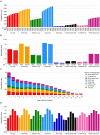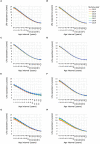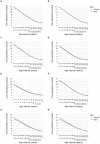Life expectancy tables for dogs and cats derived from clinical data
- PMID: 36896289
- PMCID: PMC9989186
- DOI: 10.3389/fvets.2023.1082102
Life expectancy tables for dogs and cats derived from clinical data
Abstract
There are few recent and methodologically robust life expectancy (LE) tables for dogs or cats. This study aimed to generate LE tables for these species with clinical records from >1,000 Banfield Pet hospitals in the USA. Using Sullivan's method, LE tables were generated across survey years 2013-2019, by survey year, and for subpopulations defined by sex, adult body size group (purebred dogs only: toy, small, medium, large and giant), and median body condition score (BCS) over life. The deceased population for each survey year comprised animals with a recorded date of death in that year; survivors had no death date in that year and were confirmed living by a veterinary visit in a subsequent year. The dataset totaled 13,292,929 unique dogs and 2,390,078 unique cats. LE at birth (LEbirth) was 12.69 years (95% CI: 12.68-12.70) for all dogs, 12.71 years (12.67-12.76) for mixed-breed dogs, 11.18 years (11.16-11.20) for cats, and 11.12 (11.09-11.14) for mixed-breed cats. LEbirth increased with decreasing dog size group and increasing survey year 2013 to 2018 for all dog size groups and cats. Female dogs and cats had significantly higher LEbirth than males: 12.76 years (12.75-12.77) vs. 12.63 years (12.62-12.64), and 11.68 years (11.65-11.71) vs. 10.72 years (10.68-10.75), respectively. Obese dogs (BCS 5/5) had a significantly lower LEbirth [11.71 years (11.66-11.77)] than overweight dogs (BCS 4/5) [13.14 years (13.12-13.16)] and dogs with ideal BCS 3/5 [13.18 years (13.16-13.19)]. The LEbirth of cats with BCS 4/5 [13.67 years (13.62-13.71)] was significantly higher than cats with BCS 5/5 [12.56 years (12.45-12.66)] or BCS 3/5 [12.18 years (12.14-12.21)]. These LE tables provide valuable information for veterinarians and pet owners and a foundation for research hypotheses, as well as being a stepping-stone to disease-associated LE tables.
Keywords: lifespan; longevity; mortality; obesity; survival.
Copyright © 2023 Montoya, Morrison, Arrignon, Spofford, Charles, Hours and Biourge.
Conflict of interest statement
MM, HC, M-AH, and VB were employed by Royal Canin. JM and NS were employed by Banfield Pet Hospital. FA was employed by MAD Environnement. Royal Canin SAS and Banfield Pet Hospital are subsidiaries of Mars Inc.
Figures








References
-
- Office for National Statistics . Life Expectancy Releases and Their Different Uses. (2018). Available from: https://www.ons.gov.uk/peoplepopulationandcommunity/healthandsocialcare/... (acessed July 11, 2022).
-
- American Veterinary Medical Association . Covid 19. Available from: https://www.avma.org/resources-tools/one-health/covid-19 (acessed July 10, 2022).
LinkOut - more resources
Full Text Sources
Miscellaneous

